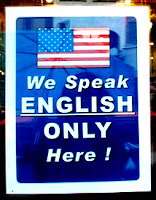When I hear people take umbrage about the use of Spanish as an option on ATMs and phone menus, it seems a clear demonstration of how easily anger can triumph over reason.
OK, suppose the “English-only” crowd gets their way. Let’s do away with all public communications in Spanish and make English the sole language of the land. Will that speed up the ATM line when someone not fluent in English is ahead of you? Will it reduce the time you wait when calling about a product problem? Will it lower the cost of products by making customer service more efficient? Please, give me a good reason. But spare me the worn-out tirade about an assault on our culture. The use of Spanish in commercial venues is not some plot hatched by a cabal of ivory-tower multiculturalists. It’s the work of business people promoting that most American of values: profit.
There are over 40 million legal Hispanic residents in the United States today. Many among this population are first generation immigrants who came here as adults and will struggle with English for the rest of their lives. It’s an inescapable fact that the human mind has a hard time adapting to new languages much past puberty. If you are a savvy business person, you’ll do everything you can to help these folks spend their hard-earned money. And why not? Stimulating the economy is good for all of us.
Today’s Hispanic immigrants know English is the coin of the realm. English lessons are a hot-selling item on Spanish-language radio and TV. The fastest-growing segment of the burgeoning Hispanic broadcast media is English-language programming. English is good. They get it. So from the Hispanic side of the issue, complaints about the use of Spanish seem mean-spirited and petty—at best. What’s next? Talk radio hosts who carp about the special parking privileges we give the handicapped?
Besides, Hispanic kids growing up today will pick up English as quickly as previous immigrant groups. Language assimilation is an unavoidable second-generation phenomenon. For the record, at the turn of the twentieth century, 600,000 students attended German bilingual schools in the United States. How many native-born German speakers do we have left today?
Some indignantly say their immigrant ancestors from previous centuries had no special language privileges. True enough. But back then women didn’t have the right to vote, racial segregation was the law of the land, and many homes lacked indoor plumbing. Should we stay mired in that kind of past? Today’s consumer technology makes offering Spanish as a response option an affordable and painless way of assimilating newcomers into our economy—unless you find pressing “1” for English simply takes too much time from your busy schedule.
Let’s face it. The complaints against the commercial use of Spanish are not based on reason. These sentiments are a symptom of a darker American tradition. Even before this land was a nation, the descendants of immigrants already here have resented the most recent arrivals. In 1751, Benjamin Franklin ranted about a fast-breeding group of “non-white” newcomers who refused to learn English and would not change their foreign ways … the German immigrants of Pennsylvania. One wonders what the Native Americans had to say about the uninvited English immigrants who arrived in Pennsylvania a century earlier.
Raul Ramos y Sanchez
